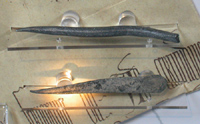 |
 |
 |
 |
 |
 |
 |
|
Fountains Abbey: History
Fountains Abbey: Buildings
|
The undercroft of the monks’ dormitory was probably used as a day-room. It occupied the southern end of the east range and dates to the mid-twelfth century.(52) The day room would have provided space for the brethren to work and perhaps also to copy manuscripts, although there is evidence that at Fountains the chapter-house might occasionally be used for this skilful work. The novices’ house The cell where the tyros
of Christ are proven. Anyone who wished to become a monk had to first undergo a year-long period of instruction in the monastic life, as stipulated in chapter 58 of the Rule of St Benedict. This was known as the novitiate and the newcomer was called a novice. The novices usually had their own separate quarters where they lived after an initial four days spent in the guest-house. Here they meditated under the tutelage of the novice-master, whose duty it was to offer encouragement and support during times of self-doubt, and to make the novices ‘worthy vessels of God and acceptable to the Order.’(53) The novices’ quarters at Fountains were located underneath the monks’ toilet block (the reredorters). The undercroft was barrel-vaulted and there was probably a fire here, to provide some comfort for these newcomers who followed a less austere regime than the monks.(54) The fifteenth-century ‘Bursar’s Account Book’ records that in 1457-8 four pennies were spent on making ten nails for the novices’ house (probatorium).(55) |

